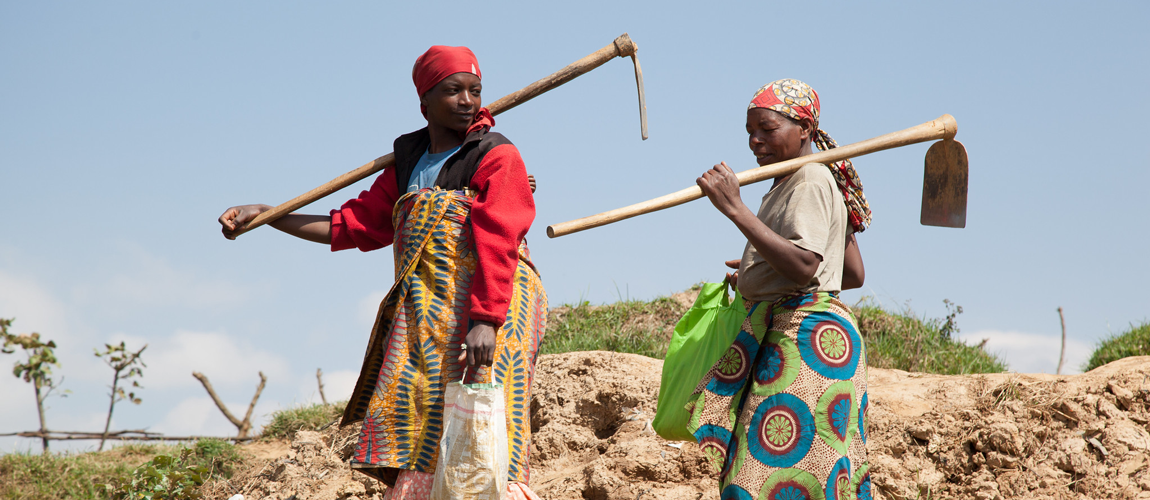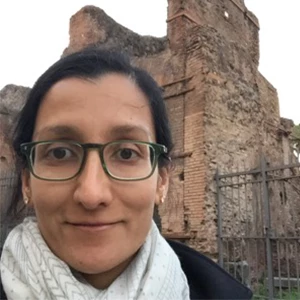 Women create terraces
Women create terraces
Across Sub-Saharan Africa, land ownership is critical for income generation, accessing credit, and transferring wealth to younger generations. As such, inequalities in land ownership often go hand in hand with inequalities in economic opportunities.
Despite the importance of land ownership for development, related research in low-income countries, particularly in Sub-Saharan Africa, has fallen short of providing representative insights regarding landowners and land rights. These insights are critical for well-targeted policymaking around land reforms, access to financial services, and extension programs.
Microeconomic research on landownership, for example, has disproportionately focused on whether individuals are documented owners (with their name on a certificate or title, for example) or reported owners (self-reported as an owner). Documented land ownership, however, is a relatively uncommon event in much of Sub-Saharan Africa with heavy reliance on customary tenure systems. In customary tenure systems, individuals who are reported owners may have varying rights (to sell or bequeath land, for example), depending on their locality and gender, among other factors. Simply knowing reported landowners without knowing their land rights can lead to misleading profiles of landowners and estimates of gender differences in land rights. Additionally, most research has been informed by small-scale studies, thus representative insights have been out of reach due to the gaps in the availability and quality of self-reported, individual disaggregated data.
In our recent working paper, we provide new, cross-country, nationally-representative insights regarding land rights among men and women in Sub-Saharan Africa. To do so, we rely on unsupervised machine learning methods and unique (publicly-available) household surveys that have been conducted in Ethiopia, Malawi, and Tanzania over the period of 2016-2020 with support from the Living Standards Measurement Study – Plus (LSMS+) program. LSMS+ supported surveys are anchored in international guidelines for individual-level data collection on asset ownership (see resources at the end of this blog).
Across the three surveys, which are comparable in terms of questionnaires and implementation protocols, adult household members were interviewed in private on a range of land ownership and rights variables. These include reported, documented, and economic ownership of land. In addition, each respondent was asked regarding his/her right to sell, bequeath, use as collateral, rent out, and invest in that piece of land (i.e. five core land rights) which are important to our work. For each of these ownership and rights constructs, respondents were asked (a) whether they had exclusive ownership and rights; (b) if not, whom they jointly owned or shared rights with; and (c) whether they needed permission/consent to exercise a specific right.
Our analysis reveals several key cross-country consistent insights:
Self-reported landowners, particularly women, often do not have full decision-making and rights
Ownership and rights and decision-making power do not necessarily go hand in hand (Figure 1). Among self-reported landowners in Tanzania, for example, 77 percent of women and 41 percent of men did not have the right to bequeath. In Malawi, while women were more likely to be landowners overall because of strong matrilineal traditions, 60 percent of women and 40 percent of men self-reported landowners did not have the right to use their land as collateral.
We also found that gender gaps in each of the five core land rights tend to be much greater than gaps in economic ownership (i.e. control over proceeds from a hypothetical sale) or decision-making (regarding timing of production activities, crop choice and input use).
Figure 1: Incidence of Non-Residential Parcel-Specific Rights, Ownership and Decision-Making Measures, by Gender of Self-Reported Landowner
Transfer rights can be used to effectively categorize landowners into three robust clusters, with implications for future survey design and analysis
The variation seen in Figure 1 highlights the difficulty of subjectively choosing which rights one should focus on. From a policymaking standpoint, being able to easily categorize groups of landowners for targeting is important. In this vein, we use different unsupervised machine learning techniques to objectively identify which sets of ownership and rights constructs matter more in understanding patterns of landownership across a diverse set of African countries.
Multiple correspondence analysis allows us to calculate a measure of variance that distinguishes landowners based on the composition of self-reported rights and control over land. Among these constructs, transfer rights (i.e. the rights to bequeath, sell, rent out, and use as collateral) consistently contribute the most to this variance.
We then rely on hierarchical clustering to show that landowners can effectively be clustered into three categories: (1) owners with mostly exclusive transfer rights, (2) owners with mostly joint transfer rights, and (3) owners with no/limited transfer rights.
Our analysis further suggests that one can predict other rights owners have just by looking at the status of their transfer rights. This implies that household survey questions on land rights can be trimmed down to only include those on transfer rights, without any loss in our ability to cluster landowners. And neither documented ownership (whose incidence is very low in the three countries) nor economic ownership appears to be influential in determining rights and decision-making in our sample.
The composition of the clusters formed in our analysis reveals stark gender differences
The clustering results, in Figure 2a below, show that women in Malawi and Tanzania are overrepresented in the cluster of landowners with no/limited transfer rights. In Tanzania, furthermore, this is despite no statistical difference in the proportion of men and women who own land.
These gender differences may vary more depending on the local customs within a country. When parsing the Malawi data into matrilineal and patrilineal marriages (Figure 2b), we find that women landowners in matrilineal marriages are more likely to be in the exclusive cluster (31 percent, compared to 16 percent for men) and vice versa for patrilineal marriages (12 percent, compared to 35 percent for men). For the “not hold” cluster, the majority in both customs are female.
Figure 2: Proportion of reported owners belonging to a cluster type
Notes: The figure shows the proportion of reported owners that belong to a cluster type. For each country, the proportions add up to one. Raw sample calculations (not weighted) of landowner observations are reported. The figure on the right is for married individuals only in Malawi since Malawi has two customs: matrilineal (land is inherited through the maternal uncle) and patrilineal marriages (land is inherited through the male heir).
The LSMS+ surveys also collected data on whether permission was needed for an individual to exercise a particular right. As expected, we found that a high proportion of owners in the “joint transfer right” cluster need permission before exercising at least one right. In the exclusive cluster, however, a larger share of women did not need to ask permission for any rights compared to men.
Overall, our findings provide much needed, nuanced perspectives on individuals’ land ownership and rights across a diverse set of Sub-Saharan African countries and sub-populations. Detailed individual-level data on asset ownership collected as part of national multi-topic household surveys have been critical in making this exploration possible.
Additional Resources
Working Paper: Multidimensionality of Land Ownership among Men and Women in Sub-Saharan Africa
Video: Advancing Gender Equality through Household Surveys: LSMS+
Guidance Document: LSMS+ Program : Overview and Recommendations for Improving Individual-Disaggregated Data on Asset Ownership and Labor Outcomes
United Nations Guidelines for Producing Statistics on Asset Ownership from a Gender Perspective
Country-Level Sex-Disaggregated Data and Gender Statistics: World Bank Gender Data Portal







Join the Conversation